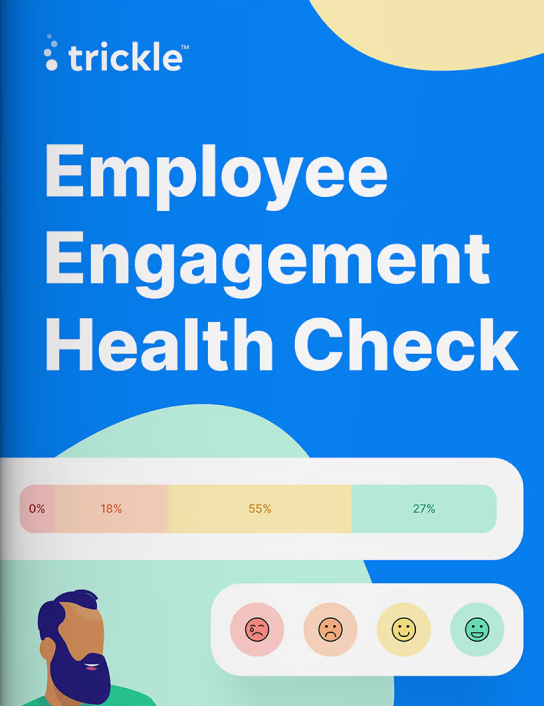How well does your company engage its employees?
Take your health check and find out.


The 4-day work week is arguably the latest talent procurement asset, so if you’re wondering whether offering it to your employees is right for your organisation, read on as we discuss its pros and cons.
30 UK companies started 2022 with a 6-month trial of the 4-day work week to see whether it increases productivity.
COVID-19 has driven interest in the idea of a 4-day work week, after hybrid and remote working models started becoming the norm. But making it the new normal will require a shift in mindset that puts life first and work second.
Businesses who have adopted the framework report a 20% gain in employee productivity. They also saw a 27% reduction in work stress levels and up to 45% improvement in work-life balance.
Adopting a 4-day framework means looking at which activities can be automated, deprioritized, or dropped, and taking action to overcome employee discomfort around change.
This is HR’s ultimate guide to the 4-day work week. Continue reading to find everything you need to know about what it is, how it’s structured, how to implement it and why it could both benefit and hinder your employees.
A 4-day work week is, ideally, a 32-hour week with no loss in productivity, pay, or benefits.
The idea behind a 4-day layout is to achieve the same results in fewer hours so people have more time to pursue other interests, spend time with loved ones, and manage their lives.
Depending on the company and the industry, everyone might work Monday to Thursday and take Fridays off. Other possibilities include allowing each employee to choose their extra day off or having a company-wide policy that every department should stick to.
The 4-day workweek may work for your organisation but first, consider the benefits and drawbacks for employees.
A 4-day week lets employees balance the time they spend working with the time they spend enjoying everything else in life: family, friends, health and hobbies.
Rearranging the working model gives employees the freedom to choose how they allocate their working hours. This autonomy empowers them to produce top quality work in the hours they’re given.
Other benefits include:
The UK 4-Day Week Campaign anticipates holiday allowances will remain the same but employers may not be willing to sustain this permanently. For those who currently work 5 days a week, this would translate to a 20% reduction in holiday allowance.
This may be considered a reasonable trade-off for an extra day off each week with no adverse impact to their pay.
It’s up to business owners, managers and HR professionals to put in place the necessary structures for a seamless move to the 4-day layout. This should include practicalities, such as:
Ultimately, with the right arrangements in place — as well as a collaborative approach between you and your staff — you should be able to manage the 4-day work week effectively to ensure an engaged, happy, and productive workforce.
Paving the way
In 2021, Iceland published the results of a pilot 4-day work week program, running from 2015 to 2019. The results showed that workers were less stressed or burnt out while having more time for family activities.
Microsoft’s Japan offices also trialled it and saw a 40% increase in productivity.
New Zealand-based firm Perpetual Guardian reported that 78% of their employees were able to balance their work and home life easier after adopting a 4-day work week. The founder says that the key to success is, “Encouraging employees to come up with their own measure of productivity,” he explained. “Make them consider how they can organise time off within teams while still meeting customer and business imperatives. Begin with a trial and engage outside consultants and academics to evaluate qualitative and quantitative measures of success.”
Thinking of trying out the 4-day work week? Trickle can help make the process easier for your business and the people in it.
Significant organisation changes like adopting a new structure can have a significant impact on employee wellbeing, productivity and job satisfaction. It’s important to check in with your teams to monitor how they’re dealing with new structural layouts — are they happy as well as productive?
Stay in touch and monitor the happiness of your employees using Trickle.
Trickle’s main activity feed is your place to have open and fun group conversations. This two-way communication tool encourages collaboration and engagement for everyone, whether that be sharing news, organising social catch ups or a space to suggest ideas.
Our MoodSense feature also lets you gauge employee feelings in real-time, helping you identify whether the new structure is helping or hindering your employees’ wellbeing and motivation.
The “How Was Your Day?” function lets you pose a simple question that when answered, gives your leadership team an idea of how happy people are feeling under the new 4-day week. Asking employees how they are is the first step in making positive change that will benefit them long term.
Find a comprehensive guide to all Trickle’s features here. Book a free demo today.